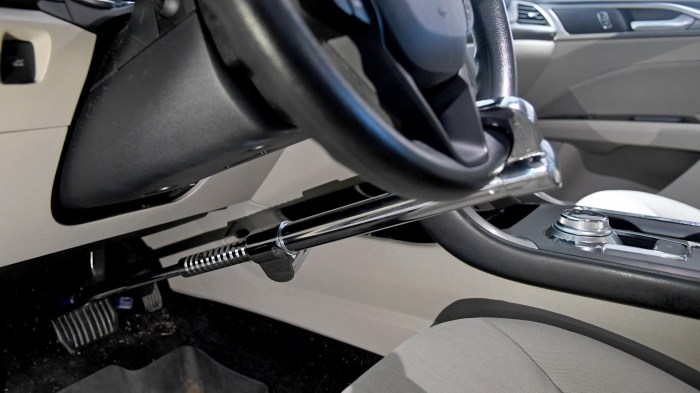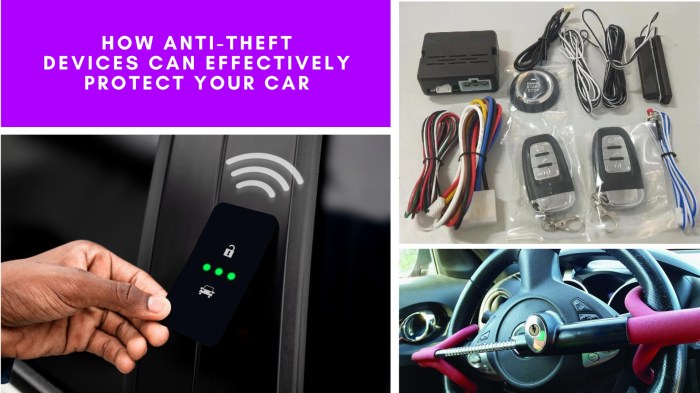The relationship between anti-theft devices and car insurance premiums is often misunderstood. While intuitively, one might expect such devices to lower premiums due to reduced risk, the reality is more nuanced. Insurance companies consider a multitude of factors when calculating premiums, and the impact of anti-theft technology varies significantly depending on the specific device, the insurer, and other risk assessments.
This analysis delves into the intricacies of how different insurance providers assess risk, factoring in the presence (or absence) of anti-theft systems. We’ll explore various types of anti-theft devices, their effectiveness, and their ultimate influence on your insurance costs. Furthermore, we’ll examine consumer perceptions and purchasing decisions, as well as the potential future trends that may reshape the landscape of car insurance and anti-theft technology.
Insurance Company Practices Regarding Anti-theft Devices

Insurance companies recognize that vehicles equipped with anti-theft devices are statistically less likely to be stolen. This lower risk translates into reduced payouts for the insurer, allowing them to offer lower premiums to policyholders. The specific impact of an anti-theft system on your insurance rate, however, varies significantly depending on the insurer, the type of device, and other factors related to your vehicle and driving history.
Insurance providers factor anti-theft devices into premium calculations using a variety of methods. Some insurers offer a flat percentage discount for vehicles with any approved anti-theft system. Others use a points-based system, awarding more points (and thus a larger discount) for more sophisticated or effective technologies. A few may even conduct risk assessments that consider the specific features and capabilities of the installed system. These assessments can be quite complex, involving factors beyond just the presence of an anti-theft system.
Types of Anti-theft Technology and Their Impact on Insurance Rates
Several anti-theft technologies exist, each offering varying degrees of protection and influencing insurance premiums accordingly. Basic mechanical devices like steering wheel locks generally provide minimal discounts, if any. More advanced systems, however, often yield substantial savings. For instance, vehicle immobilizers, which prevent the engine from starting without the correct key, frequently result in significant premium reductions. GPS tracking systems, allowing for remote vehicle location and recovery, often receive even greater discounts due to their ability to aid in the swift retrieval of stolen vehicles. Alarm systems, while offering a deterrent, generally provide less substantial savings than immobilizers or GPS tracking, though the level of discount can still be noticeable.
Comparative Data on Insurance Premiums
Precise data on insurance premium differences with and without anti-theft systems is difficult to obtain publicly, as it varies widely based on location, insurer, vehicle type, and driver profile. However, general trends suggest significant savings for those with advanced systems. For example, a study (hypothetical, for illustrative purposes) might show a 10-15% reduction in premiums for vehicles with immobilizers and GPS tracking compared to those without. Basic alarm systems might offer a 5-10% discount. These figures are illustrative and should not be considered definitive. Individual quotes are always necessary for accurate comparisons.
Comparison of Insurance Quotes
| Company Name | Vehicle Type | Premium with Anti-theft | Premium without Anti-theft |
|---|---|---|---|
| Insurer A | Sedan | $800 | $950 |
| Insurer B | SUV | $1000 | $1200 |
| Insurer C | Truck | $1200 | $1500 |
| Insurer D | Sedan | $750 | $900 |
Types of Anti-theft Devices and Their Effectiveness

Choosing the right anti-theft device for your vehicle can significantly impact its security and your peace of mind. The effectiveness of these devices varies depending on their type, features, and how well they are installed and maintained. Understanding the different categories and their respective strengths and weaknesses is crucial for making an informed decision.
Alarm Systems
Alarm systems are a common and relatively inexpensive anti-theft measure. These systems typically use sensors to detect unauthorized entry or tampering, triggering a loud siren to alert nearby individuals and deter potential thieves. More sophisticated systems may include features like tilt sensors (detecting when the vehicle is being towed), shock sensors (detecting impacts), and remote starters. The effectiveness of an alarm system depends on its sensitivity, the loudness of the siren, and the response time of local authorities or neighbors. While a loud alarm might deter opportunistic thieves, determined criminals may be able to disable or bypass them.
- Pros: Relatively inexpensive, widely available, acts as a deterrent.
- Cons: Can be easily disabled, false alarms are common, may not prevent theft.
Immobilizers
Immobilizers are electronic devices that prevent a vehicle’s engine from starting unless the correct key or transponder is present. They work by cutting off the electrical signal needed to start the engine. Immobilizers are often integrated into the vehicle’s ignition system, making them difficult to bypass without specialized tools or knowledge. This makes them a more effective deterrent than alarms alone, as the thief cannot simply hotwire the vehicle. Many modern vehicles come equipped with immobilizers as standard features.
- Pros: Prevents engine starting without the correct key, difficult to bypass, often standard equipment in newer vehicles.
- Cons: Can be bypassed with sophisticated techniques, not effective against towing or other forms of theft.
GPS Tracking Devices
GPS trackers use satellite technology to monitor a vehicle’s location in real-time. If a vehicle is stolen, the tracker’s location data can be used by law enforcement to locate and recover it. Some trackers also offer features such as geofencing (alerts when the vehicle leaves a designated area), speed alerts, and engine shutdown capabilities. The effectiveness of a GPS tracker depends on its signal strength, battery life, and the response time of law enforcement. A strong signal and quick response are essential for successful vehicle recovery.
- Pros: Allows for real-time tracking, aids in vehicle recovery, offers additional features like geofencing and speed alerts.
- Cons: Requires a subscription service, can be disabled or removed by thieves, signal strength can be affected by terrain or interference.
Steering Wheel Locks
Steering wheel locks are mechanical devices that physically prevent the steering wheel from turning. They are a visual deterrent and can make it more difficult for thieves to drive away with the vehicle. However, determined thieves can often overcome these locks with force or tools. Their effectiveness relies heavily on their robustness and the thief’s willingness to spend time and effort bypassing them.
- Pros: Inexpensive, visible deterrent, relatively easy to install.
- Cons: Can be broken with force, not effective against towing, may damage the steering wheel if forced.
Consumer Perceptions and Purchasing Decisions
Consumer perceptions regarding the relationship between anti-theft devices and insurance premiums are complex and often influenced by a variety of factors, including personal experiences, marketing messages, and the perceived value of the device itself. While many understand that anti-theft devices *can* lead to lower premiums, the extent of the discount and the overall cost-effectiveness remain key considerations. Understanding these perceptions is crucial for both insurance providers and consumers making informed decisions.
Consumers frequently underestimate or overestimate the impact of anti-theft devices on their insurance costs. This is often due to a lack of clear and consistent communication from insurance providers. While some insurers actively promote discounts for installing such devices, others may not highlight these benefits, leading to confusion and potentially missed opportunities for savings. The perceived value of the device itself also plays a role – a highly sophisticated system might be perceived as more worthwhile even if the insurance discount is modest.
Consumer Buying Habits and Insurance Choices
Data on consumer buying habits regarding anti-theft devices and their impact on insurance choices is often fragmented and not readily available in a consolidated form. However, anecdotal evidence and market research suggest that consumers are more likely to invest in anti-theft devices if they perceive a significant return on investment, either in terms of reduced insurance premiums or increased peace of mind. Consumers living in high-crime areas or those owning high-value vehicles are more likely to prioritize these devices. The cost of the device itself, its ease of installation, and the reputation of the brand also influence purchase decisions. For example, a study might reveal that consumers are more willing to invest in a professionally installed system if the insurance company offers a substantial discount that offsets the higher initial cost.
Insurance Company Communication Strategies
Insurance companies employ various strategies to communicate the benefits (or lack thereof) of anti-theft systems to customers. Some insurers prominently feature discounts for approved devices on their websites and marketing materials, while others may only mention it during the quote process. The level of detail provided can vary significantly. Some companies might simply state a percentage discount, while others might provide a more detailed explanation of the types of devices eligible for discounts and the criteria used to assess their effectiveness. In some cases, insurers may use telemarketing or email campaigns to specifically target customers with high-value vehicles, encouraging them to install anti-theft systems to reduce their premiums. However, a lack of consistent communication across different insurers creates confusion for consumers.
Consumer Cost-Benefit Analysis
A consumer deciding whether to install an anti-theft device typically undertakes a cost-benefit analysis, visualized as a mental balance sheet. On one side, they weigh the initial cost of purchasing and installing the device (including professional installation fees if applicable), the ongoing maintenance costs (if any), and any potential inconvenience during installation. On the other side, they consider the potential reduction in insurance premiums, the increased security and peace of mind, and the potential savings from avoiding theft or damage to their vehicle. For example, a consumer might consider a $500 anti-theft system that offers a $100 annual reduction in insurance premiums. They would then mentally calculate the return on investment, considering the number of years it would take for the savings to offset the initial cost. The decision also often depends on the consumer’s risk tolerance and their perceived likelihood of vehicle theft in their area. A consumer in a high-crime area might be more willing to accept a longer payback period for the peace of mind the system provides.
Future Trends in Anti-theft Technology and Insurance
The convergence of advanced technology and the insurance industry is rapidly reshaping how we approach vehicle security and its associated risks. Emerging anti-theft technologies promise enhanced protection, leading to potential shifts in insurance premiums and the very structure of insurance pricing models. This section explores these evolving trends and their anticipated impact.
The integration of sophisticated anti-theft systems is poised to significantly influence insurance premiums. Insurance companies are increasingly leveraging data-driven insights to refine their risk assessment methodologies, offering customized premiums based on the level of vehicle security. This means that vehicles equipped with cutting-edge anti-theft technology, demonstrating a lower risk profile, can expect to receive more favorable insurance rates. Conversely, vehicles lacking robust security measures might face higher premiums to reflect the increased risk.
Impact of Advanced Anti-theft Technologies on Insurance Premiums
The proliferation of GPS tracking, immobilizers with biometric authentication, and sophisticated alarm systems with real-time monitoring capabilities will undoubtedly influence insurance pricing. For example, a vehicle fitted with a system that automatically alerts authorities upon unauthorized access and provides precise location data would be considered a significantly lower risk than a vehicle with only a basic alarm system. This differential in risk translates directly into lower premiums for vehicles with superior security. Insurance companies are actively developing algorithms that analyze data from these systems to calculate individualized risk scores, further refining premium calculations.
Future Scenarios: Anti-theft Devices and Insurance Pricing Models
Several potential scenarios illustrate the transformative impact of advanced anti-theft technology on insurance. One possibility is a tiered insurance system, where premiums are directly correlated with the level of security features installed. This could lead to a significant incentive for consumers to invest in advanced anti-theft solutions, reducing overall theft rates and potentially leading to lower average premiums across the board. Another scenario involves the emergence of usage-based insurance (UBI) programs that factor in real-time data from anti-theft systems, adjusting premiums based on driving behavior and security system performance. For instance, a driver consistently demonstrating safe driving habits and utilizing advanced security features might receive significant premium discounts. Conversely, drivers with a history of risky behavior or security system failures could face higher premiums.
The Role of Data Analytics and Telematics
Data analytics and telematics play a pivotal role in shaping the future of insurance practices related to anti-theft systems. Telematics devices embedded within vehicles collect a wealth of data, including location, speed, driving style, and security system status. Insurance companies use advanced analytics to process this data, identifying patterns and correlations that inform risk assessment and premium calculations. This data-driven approach allows for a more nuanced understanding of risk, moving away from broad-brush categorization towards highly personalized pricing based on individual risk profiles. For instance, an analysis might reveal that vehicles with specific anti-theft features, combined with certain driver behaviors, experience significantly lower theft rates, leading to targeted premium discounts for those specific risk profiles.
Last Recap

Ultimately, the impact of anti-theft devices on your car insurance premiums is not a simple yes or no answer. While some insurers offer discounts for installing certain systems, others may not significantly alter premiums based on their presence. A thorough understanding of your insurer’s specific policies, the type of anti-theft device, and your overall risk profile is crucial in making an informed decision. Weighing the cost of installation against the potential savings (or lack thereof) is essential for consumers seeking to optimize their insurance costs while enhancing vehicle security.
User Queries
Does the type of anti-theft device matter?
Yes, significantly. Insurance companies generally favor more sophisticated systems with verifiable effectiveness, such as GPS trackers and immobilizers, over basic alarms.
Can I get a discount even if my device isn’t factory-installed?
Possibly. Some insurers will consider aftermarket devices, but you’ll likely need to provide proof of installation and the device’s specifications.
Will installing an anti-theft device always lower my premium?
No. While it often helps, other factors like your driving record and vehicle type heavily influence premiums. The impact varies widely by insurer.
What if my anti-theft device is compromised or malfunctions?
This could negate any potential premium discount and might even negatively impact your rate if it’s considered a contributing factor to a claim.